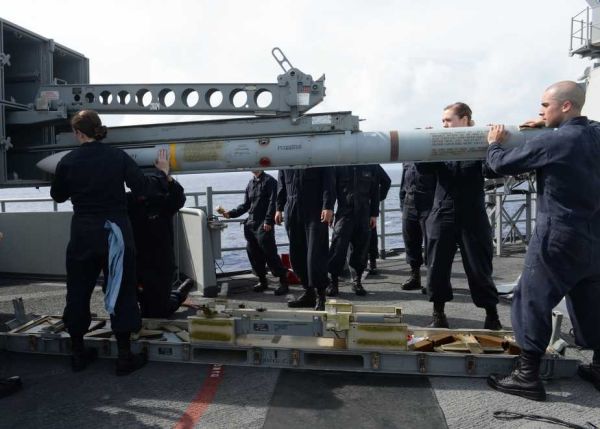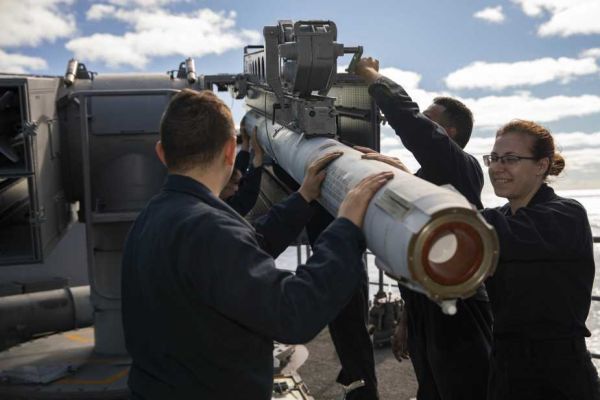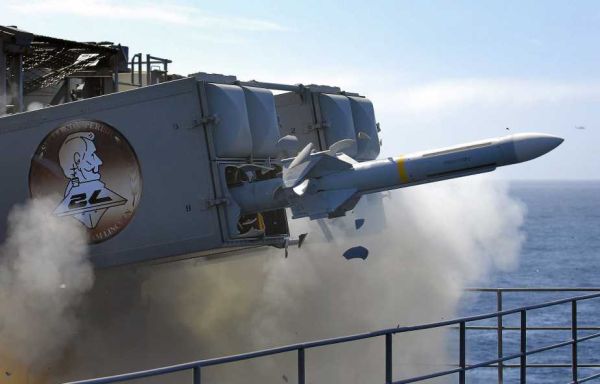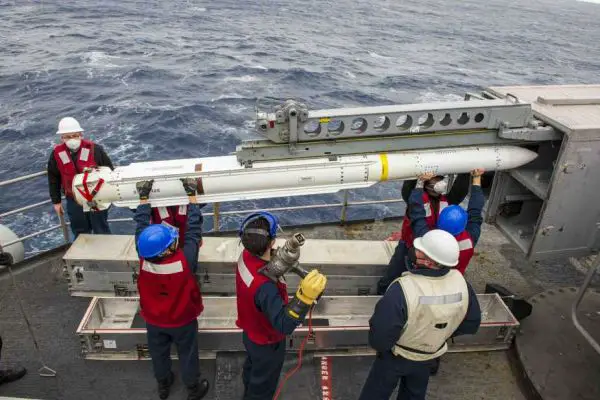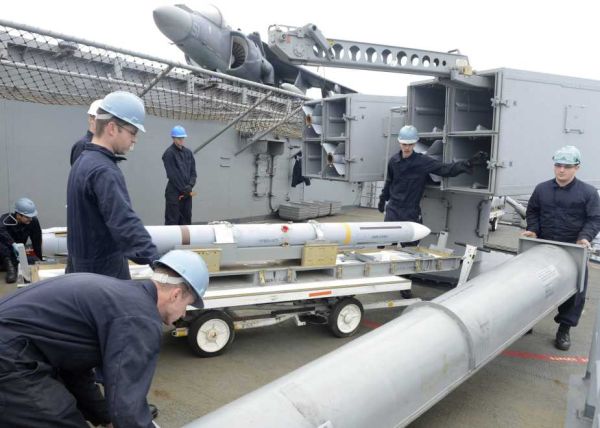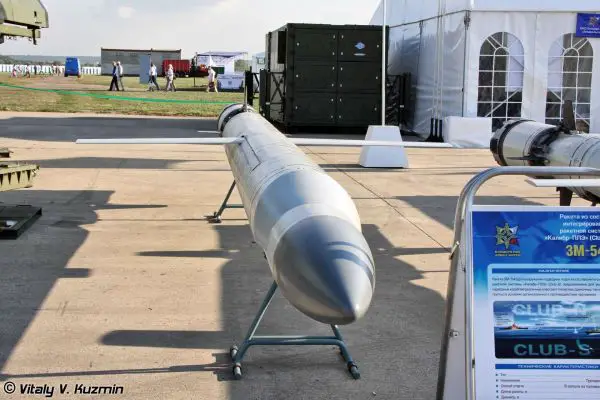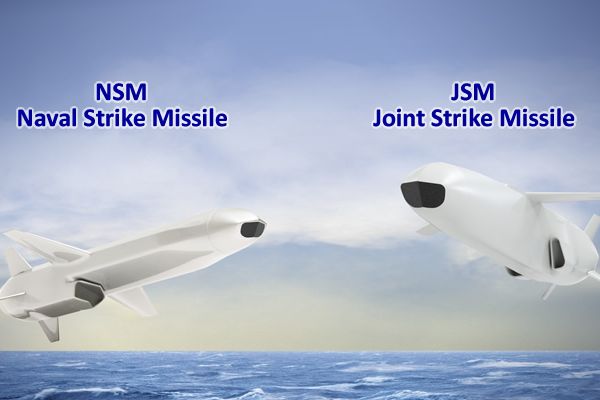Missiles.
RIM-7 Sea Sparrow Surface-to-Air Missile.

The RIM-7 Sea Sparrow is a radar-guided, medium-range surface-to-air missile designed primarily for naval air defense. Developed to counter a variety of aerial threats, including anti-ship missiles, aircraft, and unmanned aerial vehicles (UAVs), the Sea Sparrow has been a key component of naval defense systems since its introduction in the 1970s. Manufactured by Raytheon (originally by Hughes Aircraft), this missile system has undergone numerous upgrades to meet the evolving threat landscape. With its ability to intercept supersonic threats at varying ranges, the Sea Sparrow is considered one of the most versatile and widely deployed air defense missiles on naval platforms.
Country users: United States, Australia, Canada, Denmark, Greece, Japan, Netherlands, Norway, Spain, Turkey, United Kingdom, South Korea, Germany, Saudi Arabia, Qatar.
Country Producer
Description
The RIM-7 Sea Sparrow is a surface-to-air missile that was developed by the United States to provide naval ships with a defense against incoming airborne threats. The missile is designed to engage targets such as anti-ship cruise missiles, fast aircraft, and UAVs, offering critical protection for high-value naval assets. The Sea Sparrow was first developed in the 1960s as a derivative of the AS-7 Sparrow air-to-air missile, with modifications to tailor it for surface launch platforms.
The missile entered into service in 1976, initially to equip U.S. Navy ships with enhanced missile defense capabilities against incoming aerial threats. Over the years, the Sea Sparrow has seen several upgrades, including improvements to its guidance system, warhead, and propulsion to counter newer and more advanced threats. These updates have kept the Sea Sparrow relevant and effective in modern naval operations.
The missile system is primarily used for fleet air defense and is designed to intercept a broad range of targets. It is capable of engaging both low and high-altitude threats, with a focus on intercepting high-speed cruise missiles. The Sea Sparrow can be launched from both Vertical Launch Systems (VLS) and traditional deck-mounted launchers, allowing it to be employed on a variety of ship classes, including destroyers, frigates, and aircraft carriers. Recent deployments include ships such as the USS Porter (DDG-78), which operates the Sea Sparrow to defend against airborne threats in operational theaters like the Mediterranean and the USS Stout (DDG-55) in the Pacific.
RIM-7 Sea Sparrow Surface-to-Air Missile variants:
- RIM-7A Sea Sparrow: The original variant, introduced in 1976. Based on the AIM-7 Sparrow, the RIM-7A was designed as a surface-to-air missile (SAM) for naval defense, featuring a semi-active radar homing system for targeting aircraft and anti-ship missiles.
- RIM-7B Sea Sparrow: Introduced in the mid-1980s, the RIM-7B upgraded the original RIM-7A with improvements in the guidance system, offering better target acquisition, more effective engagement against supersonic missiles, and improved resistance to jamming and countermeasures.
- RIM-7C Sea Sparrow: The RIM-7C variant, deployed in the late 1980s, featured further improvements in guidance and propulsion systems, enhancing performance against high-speed anti-ship missiles. It also offered better integration with advanced fire control systems on ships.
- RIM-7E Sea Sparrow: Entering service in the early 1990s, the RIM-7E featured an upgraded radar seeker for greater precision, better countermeasure resistance, and the ability to engage a wider variety of targets, including low-flying anti-ship missiles. This variant also allowed for Vertical Launch System (VLS) compatibility.
- RIM-7P Sea Sparrow: Introduced in the late 1990s, the RIM-7P incorporated a multimode radar seeker, allowing for more effective engagement in diverse operational environments. It featured upgraded electronics and VLS compatibility for rapid launches from modern naval platforms.
- RIM-162 ESSM (Evolved Sea Sparrow Missile): The most advanced variant, the ESSM, introduced in the early 2000s, was developed as a joint NATO and U.S. program. It boasts an active radar seeker, enhanced maneuverability, and extended range, making it capable of intercepting more advanced supersonic missiles. The ESSM is also optimized for Vertical Launch Systems (VLS) and integration with modern Aegis Combat Systems.
- RIM-7X Sea Sparrow: The RIM-7X, developed in the early 2010s, is an interim upgrade focused on enhancing radar capabilities and countermeasure resistance. It is designed for platforms that need to maintain effectiveness against modern threats while being a cost-effective solution for older Sea Sparrow versions.
Technical Data
-
Design
The RIM-7 Sea Sparrow is a compact and aerodynamically refined missile designed to be both lightweight and effective in countering a wide variety of airborne threats. Its design reflects its specific role as a surface-to-air missile optimized for naval air defense.
The missile features a cylindrical body, which measures approximately 3.66 meters (12 feet) in length and has a diameter of 0.18 meters (7.1 inches), providing a streamlined profile ideal for its high-speed flight. The front section of the missile houses the radar seeker, a crucial component for its semi-active radar homing guidance system. This seeker is mounted within a nose cone that tapers to minimize air resistance and improve the missile’s aerodynamic performance during flight.
The wings of the Sea Sparrow are mounted towards the middle of the missile's body, contributing to its stability during flight. These low-mounted, fixed wings span approximately 1.15 meters (45 inches) and are designed to maintain the missile’s maneuverability at high speeds. The wing design also ensures that the missile can maintain stability during its flight path while undergoing sharp turns to intercept fast-moving targets.
At the rear of the missile, the tail fins are equipped with four large fixed stabilizer fins, which provide additional control and ensure a stable flight trajectory. These tail fins are essential for maintaining the missile’s accuracy in the final phase of its interception.
The missile's propulsion system is housed in the tail, with a solid-fuel rocket motor that powers the missile to speeds of up to Mach 2.5. This powerful engine allows the missile to reach supersonic speeds, ensuring rapid interception of fast-moving aerial threats.
Overall, the missile’s design is optimized for rapid launch and flight, with a balance between stability and maneuverability to ensure effective interception of high-speed targets, such as incoming anti-ship missiles or aircraft. Its compact size allows for efficient storage and launch from both Vertical Launch Systems (VLS) and traditional deck-mounted launchers, making it versatile and adaptable for use on a wide range of naval platforms. The Sea Sparrow's overall physical design allows it to be deployed quickly and accurately, providing a reliable air defense capability for modern naval forces.
-
Warhead
The Sea Sparrow is equipped with a high-explosive fragmentation warhead designed to destroy or disable incoming missiles and aircraft. The warhead weighs approximately 34 kg (75 lbs), providing an effective balance of size and destructive power. Upon detonation, the warhead releases a burst of shrapnel that can incapacitate the target through kinetic energy and blast effects, making it particularly effective against high-speed, hard-to-hit targets such as anti-ship missiles.
This fragmentation warhead is designed to ensure maximum damage over a wide area, increasing the probability of intercepting small, fast-moving targets. It is especially effective in scenarios where a direct hit might be difficult due to the maneuvering capability or high speed of the threat. The Sea Sparrow’s warhead provides substantial lethality against air threats, ensuring that even near misses can result in significant damage to an incoming missile or aircraft.
-
Propulsion
The RIM-7 Sea Sparrow is powered by a solid-fuel rocket motor, which gives the missile its high speed and rapid acceleration. This propulsion system allows the Sea Sparrow to reach speeds of up to Mach 2.5, enabling it to engage supersonic targets effectively. The solid-fuel engine provides a relatively simple but reliable means of propulsion, ensuring consistent performance in a variety of environmental conditions.
In terms of range, the missile is capable of striking targets at a maximum distance of around 15 to 25 kilometers (9 to 16 miles). This range is sufficient for intercepting incoming threats before they can close in on the defended ship, providing an effective air defense perimeter. While the missile's range is influenced by factors such as target altitude, atmospheric conditions, and flight profile, it remains effective within the typical engagement distances for naval air defense.
-
Guidance Systems
The Sea Sparrow utilizes a semi-active radar homing guidance system, which enables the missile to lock onto and track targets with precision. In the mid-course phase, the missile is guided by radar signals reflected from the target, allowing it to close in on the enemy vessel or aircraft. During the terminal phase, the missile uses its onboard radar seeker to engage the target with continuous wave radar, offering high accuracy in the final moments of flight.
The missile's radar system is capable of engaging fast-moving targets, even those with small radar signatures, and can operate in challenging electronic warfare environments, providing it with increased resistance to countermeasures. This combination of semi-active radar guidance and monopulse radar seeker makes the Sea Sparrow highly effective against modern anti-ship missiles and aircraft.
-
Combat Use
The RIM-7 Sea Sparrow is primarily used for fleet air defense, tasked with protecting ships from various airborne threats such as anti-ship cruise missiles, fast aircraft, and UAVs (Unmanned Aerial Vehicles). It is designed for engagements at medium ranges, with an effective interception range of 15 to 25 kilometers (9 to 16 miles). The missile is particularly effective in intercepting low-flying, high-speed threats that may attempt to evade radar detection or launch from a short distance.
The Sea Sparrow's versatility extends to both defensive and offensive naval operations. In fleet air defense, it ensures that high-value targets such as aircraft carriers and amphibious assault ships are shielded from incoming attacks, offering a reliable layer of protection. The missile's ability to intercept anti-ship missiles, which typically approach at high speed and low altitude, makes it a vital component of modern naval defense systems. In addition to protecting ships from direct hits, the Sea Sparrow's warhead ensures that even near misses can cause sufficient damage to neutralize a threat, further enhancing its effectiveness in naval combat.
Specifications
-
Type
Surface-to-air missile (SAM), medium-range, radar-guided.
-
Country users
Australia, Canada, Denmark, Greece, Japan, Netherlands, Norway, Spain, Turkey, United Kingdom, United Staes, South Korea, Germany, Saudi Arabia, Qatar.
-
Designer Country
United States (Initially developed by Hughes Aircraft, now produced by Raytheon).
-
Engine Missile
Solid-fuel rocket motor.
-
Range Missile
15 to 25 kilometers (9 to 16 miles).
-
Speed Missile
Mach 2.5 (approximately 3,000 km/h or 1,864 mph).
-
Guidance Systems Missile
- Semi-active radar homing (RIM-7A to RIM-7P),
- Active radar homing (RIM-162 ESSM). -
Launch Weight Missile
Approximately 227 kg (500 lbs).
-
Launchers
Vertical Launch System (VLS), MK 29 GMLS, MK 48 GMLS (for deck-mounted launchers), and various ship-based launchers compatible with Aegis Combat Systems and other naval platforms.
-
Dimensions Missile
Length: 3.66 m; Diameter: 0.18 m; Wingspan: 1.15 m





























